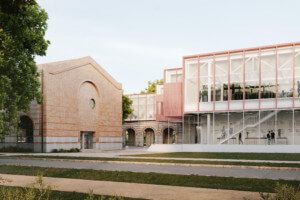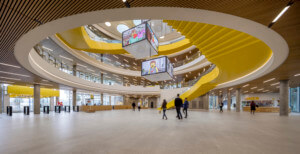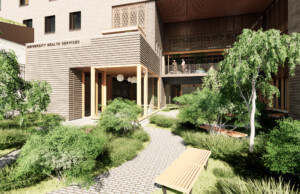“The eye-catching screen reflects the innovation and creativity that characterizes the various institutes which it unites.”
The University of Southern Denmark has a new, shared research and education facility by C. F. Møller Architects that combines four academic research institutes into one shared academic research facility. The various groups are connected by a central canyon-like social space with bridges that span the atrium overhead, linking the institutes. The organization of the building is primarily influenced by SDU’s 1970’s era structuralist campus design by architects Krohn & Hartvig Rasmussen that incorporated reinforced concrete construction and cor-ten steel in a linear site layout.
The building envelope is predominantly a glass curtainwall with a custom exterior concrete screen made from pre-fab panels of white CRC concrete (Compact Reinforced Composite, a special type of Fiber Reinforced High Performance Concrete with high strength) featuring circular openings with an underlying solar screen and natural ventilation.
- Facade Manufacturer
HiCon (CRC panels); HS Hansen (window units) - Architects
C. F. Møller Architects - Facade Installer
HS Hansen - Location
Odense, Denmark - Date of Completion
2015 - System
compact reinforced panels on steel frame - Products
“Hansen Fasad” windows from HS Hansen, custom fiber-reinforced high performance concrete screen
The architects say that the composition of the screen avoids a dull repetitive patterning, yet manages to save costs due to a modular assembly comprised of only 7 unique cast profiles. Data from key views, solar shading, and structural requirements provide parameters to control circular opening sizes (from 4 inches to 6 feet in diameter) and locations with respect to interior functions. Structural integrity of the panel connection points added further challenges to the design of the custom screen. Julian Weyer, partner at C. F. Møller, says a collaboration between the fabricator and installer simplified the process: “mockups were used to qualify the design process and especially the design possibilities and constraints of the concrete screen.” The circular patterning of the CRC screen extends onto the roof where variously sized circular skylights bring daylight into the central atrium. This establishes one of the most successful spaces in the building. “The experience of the day lit ‘canyons’ inside and between the labs feels both intimate and spacious,” Weyer says.
The building meets the strict Danish building code requirements for low-energy class 2015, which addresses various environmental criteria including minimal energy consumption, good indoor climate and use of materials with a low environmental impact in a life cycle perspective.
While the project was designed roughly at the same time as Henning Larsen Architects’ Kolding Campus, a mere 7-minute walk away, the two SDU projects were not directly influential on each other, however Weyer says both contribute to “an already solid Danish tradition for open ‘learning landscapes’ and innovative educational buildings” citing prior C. F. Møller projects such as the Maersk Building in Copenhagen, the A.P. Møller School in Schleswig and the Vitus Bering Innovation Park in Horsens as notable precursors.










